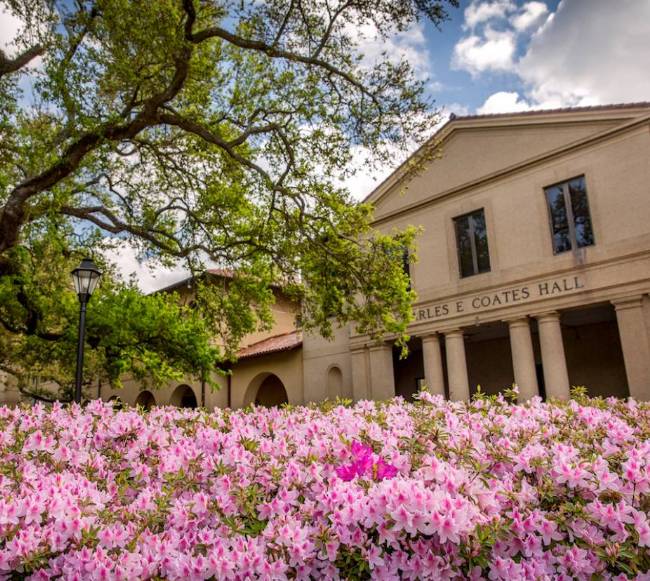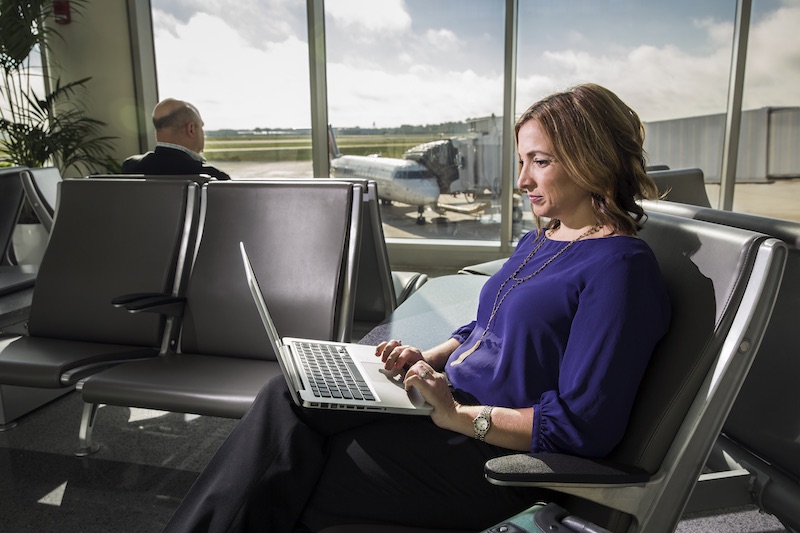Hurricane Katrina: LSU’s Role in Response, Recovery, Resilience, and Research
August 08, 2025
In the wake of Hurricane Katrina, LSU’s campus became—in the words of Frances Fragos Townsend, President George W. Bush's homeland security adviser—“one of the largest peacetime triage operations in U.S. history.”
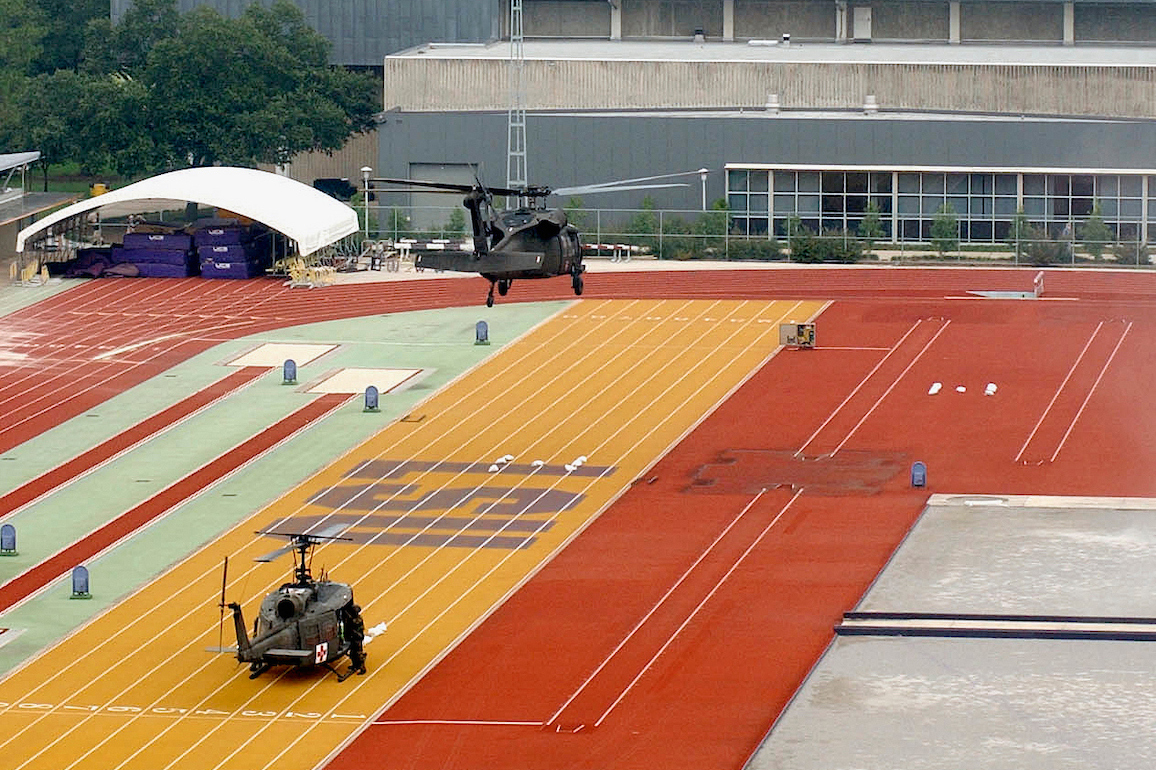
A helicopter lifts off and a second prepares to lift off from the Bernie Moore Track Stadium sprint track on the LSU campus.
When Hurricane Katrina made landfall 20 years ago, on August 29, 2005, it was one of the most catastrophic natural disasters in U.S. history. Striking southeast Louisiana as a Category 3 storm, Katrina brought devastating winds and storm surges that overwhelmed New Orleans’ levees, submerged neighborhoods, and displaced hundreds of thousands of residents.
It is among the deadliest storms to ever strike the U.S. The storm is blamed for more than 1,000 deaths in Louisiana and hundreds more across the Gulf Coast.
The 2005 hurricane season, which also included Hurricane Rita, not only tested the resilience of Louisiana’s infrastructure and communities but also revealed the critical importance of coordinated emergency response, long-term recovery efforts, and scientific research in the face of disaster.
— Video by Callie Boyd
READ MORE: Former Chancellor: How LSU Overcame the Chaos to Become a Beacon of Hope in Katrina’s Aftermath
Louisiana Impact & LSU’s Response
New Orleans and the surrounding areas bore the brunt of Katrina. More than 80% of New Orleans was flooded, and Plaquemines Parish and St. Bernard Parish were rendered nearly uninhabitable.
“I don't think anybody believed, thought, or could have the imagination at the time to think about the fact that this was going to create a diaspora from New Orleans and the entire Gulf Coast area in the Southeast,” said Sean O’Keefe, LSU’s chancellor during that time.
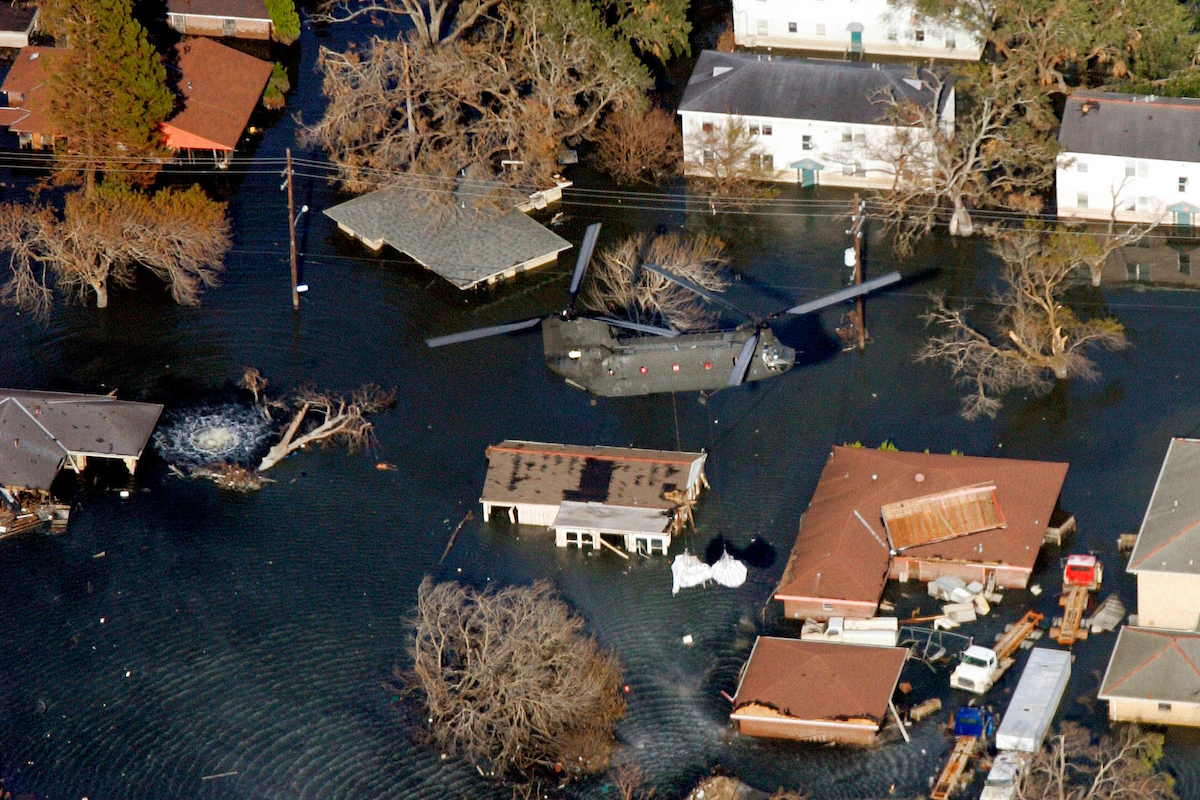
A helicopter hovers over flooded buildings in New Orleans.
Michael Antoine, associate vice president of LSU’s campus safety, preparedness & emergency response, was a firefighter/EMT with the New Orleans Fire Department during Hurricane Katrina. He was part of the first response teams providing critical firefighting services, conducting search and rescue operations, and delivering humanitarian aid before, during, and long after the storm passed, working around the clock to save lives and restore some safety and stability amid overwhelming devastation.
“There are moments from Katrina that will stay with me forever—the look in people’s eyes when we pulled them from flooded homes, the overwhelming silence of neighborhoods underwater, and the deep sense of abandonment many felt. One that haunts me is seeing families trapped for days on rooftops, waiting for rescue,” Antoine said.
READ MORE: He Stayed Through the Storm; Now He’s Helping LSU Prepare for the Next One
Baton Rouge, about 80 miles northwest, became a hub for evacuees and emergency operations. Its population nearly doubled as displaced residents moved into the capital city.
“In 2005, I was a PhD student at the University of New Orleans working on my PhD in urban studies and ecosystem management. I was also a practicing planner working for a small planning firm in New Orleans. (Because of Katrina) I evacuated to Zachary, Louisiana, with two dogs and two cats, and just thought it would be kind of three days spent in Baton Rouge before you went home,” said Traci Birch, an associate professor in the LSU School of Architecture at LSU and the associate director of the LSU Coastal Ecosystem Design Studio.
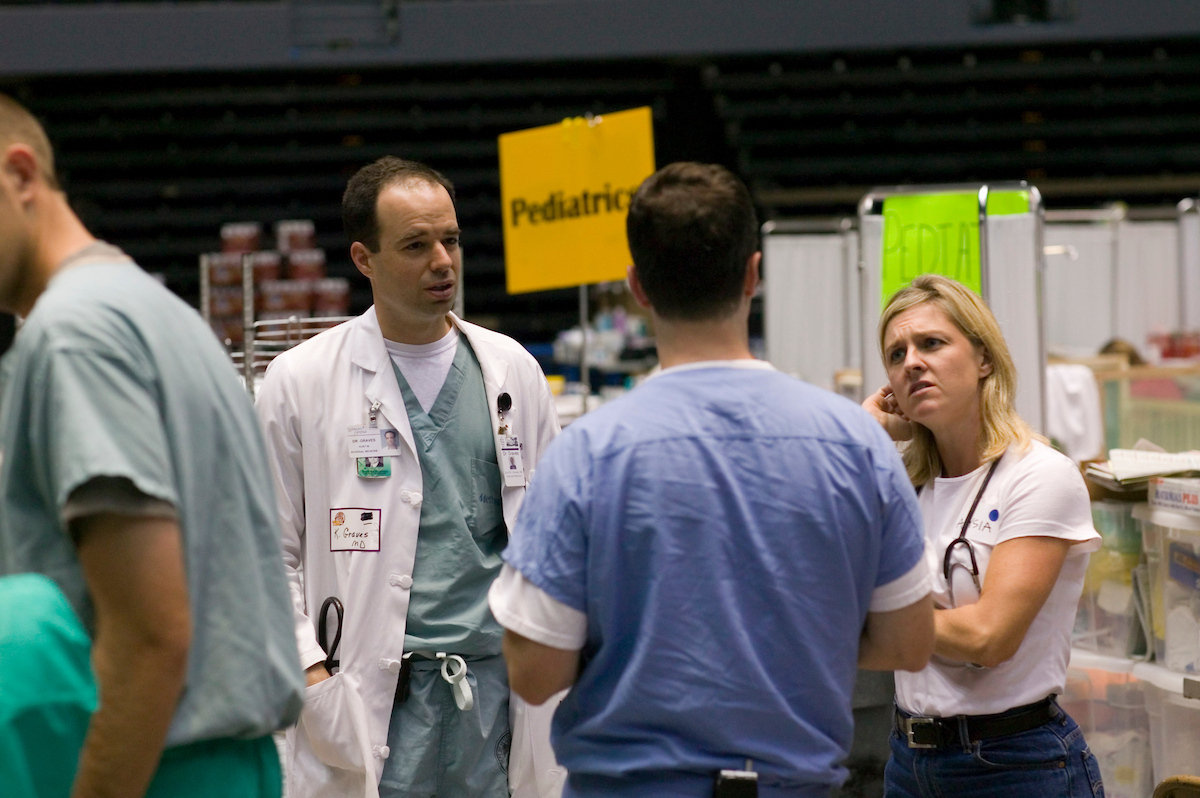
Medical workers consult inside the field hospital at LSU's Pete Maravich Assembly Center.
LSU quickly became an epicenter of support. The university transformed into an operational base for state and federal agencies.
“All roads passed through Baton Rouge, and all the power was out everywhere, except at LSU,” O’Keefe said.
The university coordinated with the Governor’s Office, FEMA, and military units, making its facilities and resources available for rescue and relief. The Pete Maravich Assembly Center was turned into a makeshift hospital, where medical professionals treated more than 6,000 patients. LSU faculty, staff, and student volunteers mobilized within hours to help with triage, logistics, and recovery support.
“Within 24 hours, all the physicians who were there, all the medical, staff and personnel who came from the hospitals immediately knew exactly how to set this up to create a triage operation. The most desperate folks go here, the ones with the least amount of problem, go over there. And it went from chaos to a very organized,” O’Keefe said. “It was uplifting. It was one of those things that really did give you a sense of the reassurance of the capacity of humans to take care of each other in the worst of situations regardless of what your views are or your background or your ethnicity or anything. None of that mattered.”
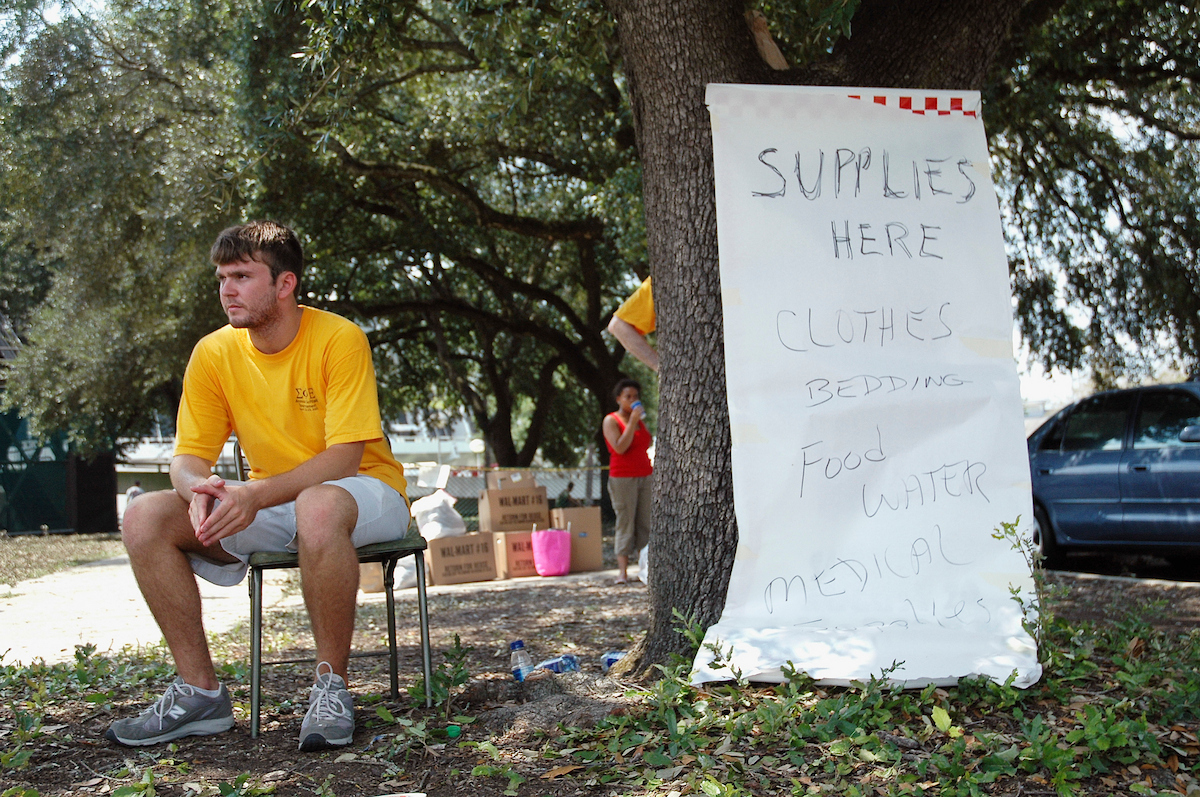
LSU student Matthew Giglia staffs a supply distribution site on campus.
The LSU Community Steps Up
STUDENT VOLUNTEERS. LSU students answered the call to help as well. O’Keefe said students would fill the stands of the PMAC around the clock.
“There were so many students who showed up with great regularity, two o'clock in the afternoon, two o'clock in the morning, they were there. There would be hundreds of them who would come in volunteering to empty bed pans, all the basic things that these medical professionals needed help with,” O’Keefe said.
HELP FOR DISPLACED STUDENTS. Immediately following the storm, the ten colleges based in New Orleans were forced to suspend classes. Nearly 3,000 displaced students were enrolled at LSU after Katrina. A one-stop registration center was established to expedite the application, registration, and orientation processes. LSU’s Office of Student Aid and Scholarships organized a Hurricane Katrina/Rita Student Relief Fund to help students who had lost financial support or were displaced by the hurricanes and related floods. LSU also continued to offer shelter, serve meals, and maintain some academic continuity for its own students and displaced students from universities in New Orleans, even some students’ families joined their Tigers in residence halls.
“There was a real desperation,” O’Keefe said.
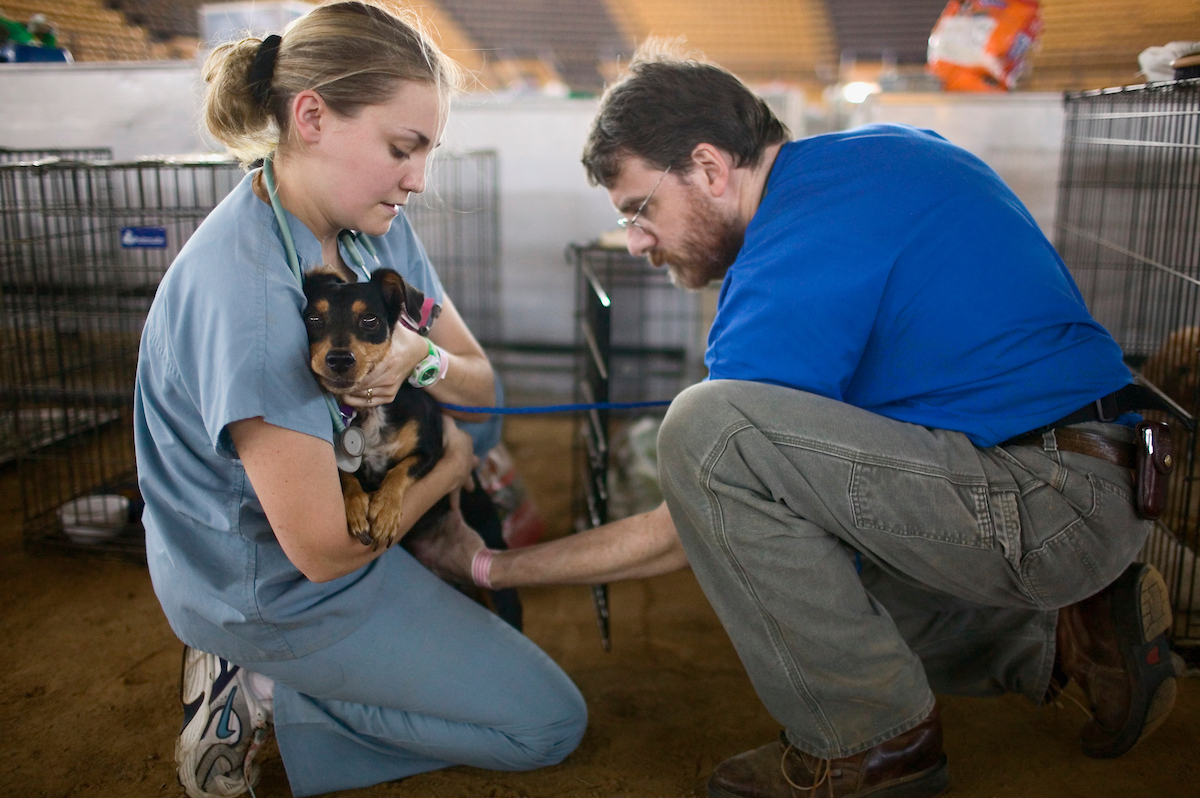
A dog is examined at the LSU AgCenter animal shelter on campus.
SHELTER FOR PETS, OTHER ANIMALS. Animal care was another area of need, where LSU mobilized to help residents and their pets. Faculty from the School of Veterinary Medicine helped rescue and treat animals. The Parker Coliseum was transformed into a temporary shelter for displaced animals, offering critical support to storm survivors who couldn’t take their pets with them.
In just 48 hours, the shelter housed more than 500 animals, eventually reaching nearly 2,000, including dogs, cats, goats, and more. LSU provided this free animal care to residents evacuating New Orleans, even microchipping pets to help with future reunification. LSU provided half a million dollars in free animal care to residents evacuating New Orleans.
AID FOR FARMERS & RANCHERS. In addition, the LSU AgCenter provided emergency services to affected farmers and helped coordinate the distribution of food and supplies across rural communities. Cattle producers in southeastern, southwestern and south-central Louisiana took a devastating hit from hurricanes Katrina and Rita. LSU AgCenter estimates showed that almost 200,000 cattle were being raised in the affected areas. Thousands of those were lost in the storms and even more were left stranded without food or water. LSU AgCenter agents facilitated meetings to discuss feed and hay situations and the status of stranded cattle, as well as leading some of the rescue efforts and coordinating getting much-needed supplies to the area.
Research Rooted in Recovery
The devastation caused by Katrina and then Rita sparked a new wave of research at LSU focused on understanding, responding to, and preventing large-scale disasters.
By using data from Katrina and other hurricanes during the following decade, researchers were able to improve computationally intensive forecasting tools and help guide better ecosystem planning and levee design.
LSU engineers and computer scientists built advanced models to simulate flooding and infrastructure designs, helping shape smarter evacuation strategies and more resilient coastal lives.
“Katrina changed my career path, to be honest, because now I wanted to not only stay in wetland science, but I wanted to think about wetlands and people’s much stronger connection than I had in the past, and how we can influence where we put communities and where we put wetlands,” said Robert Twilley, vice president of research and economic development at LSU, former executive director of Louisiana Sea Grant and a coastal ecosystem scientist.
LSU researchers took critical lessons from Hurricanes Katrina and Rita that reshaped the way the university now approaches coastal challenges, including creating new environments, focusing on data-driven design of natural and built environments.
Hurricane Rita Delivers a Second Blow to Louisiana
Less than a month after Hurricane Katrina, Louisiana faced another strong hurricane in the Gulf of Mexico. Rita formed on September 18, 2005, near the Bahamas and quickly reached Category 5 status.
Hurricane Rita made landfall as a Category 3 hurricane in Johnson's Bayou, near the Louisiana-Texas border, bringing a very strong storm surge ranging from 7 to 18 feet along the coast and rainfall of up to 16 inches to areas already damaged by Hurricane Katrina. The damage from Hurricane Rita left many without homes or electricity, totaling $18.5 billion, and caused around 120 deaths across four states.
“Katrina made it real around what are we gonna do around the urban areas. Rita made us think about rural areas,” Twilley said. “Those two hurricanes were instrumental to our thinking, and it really changed what we do here at LSU.”
“There’s also a broader focus on learning to live with water. No community is completely safe from disaster impacts anymore. And since Katrina, we’ve seen other major storms like Harvey and Michael, there’s a pattern, and we have to plan for that,” Birch said.
“We’re not doing hypothetical scenarios; we’re doing real-life, and I think that’s given us the competitive edge compared to any other university that’s doing this work, and we export it,” Twilley said. “Forecasting flooding, saving lives, protecting the health and safety of our communities. If we don’t do that and step up as a public research university, then that's a horrible loss of a value proposition to Louisiana.”
LIFE-PROTECTING PARTNERSHIP. Following Katrina and Rita, the Louisiana Legislature created the Coastal Protection and Restoration Authority, or CPRA, and tasked it with coordinating local, state, and federal efforts to achieve comprehensive coastal protection and restoration. Its goal is to protect the lives and livelihoods of more than two million people in Louisiana, whether it’s through marsh creation, barrier island restoration, sediment diversions, levee construction, or other large-scale projects to decrease the risks of the state slowly slipping into the sea.
“Our partnership with the state and CPRA that followed Katrina positioned LSU as a trusted partner in building a better future for all of Louisiana and its coastal and riverine communities,” Twilley said. “Katrina helped solidify our mission as the flagship university of the state—we’re here to save and improve lives and to put science to work for regular people, who really needed us to step up in that moment, and help.”
STORM SURGE FORECASTING TOOL. LSU’s efforts in storm resilience and preparedness include CERA, the Coastal Emergency Risks Assessment, which shows projected storm surge and flooding on an easy-to-use Google map, helping emergency managers and first responders protect people and infrastructure across Louisiana and beyond. CERA collaborates closely with CPRA and serves emergency response teams in most coastal states, including FEMA, the Army Corps of Engineers, and every branch of the U.S. military.
MENTAL & PHYSICAL HEALTH IMPACTS. Public health, geography, sociology, and social work researchers at LSU studied the mental and physical health impacts on displaced residents, especially vulnerable populations like the elderly and children. Their findings helped shape policies around disaster response, housing, and healthcare. LSU law and public administration experts, meanwhile, examined legal and bureaucratic breakdowns that delayed aid and complicated recovery, offering solutions to streamline future disaster response.
DISASTER RESILIENCE RESEARCH. In the years since Katrina, LSU has become a national leader in disaster resilience research. The university now plays a central role in statewide emergency preparedness, contributing expertise on everything from climate change adaptation and flood risk management to home building and community rebuilding. LSU’s research has informed FEMA protocols, influenced building codes, and helped Louisiana communities prepare for hurricanes like Gustav, Ida, and future storms yet to come.
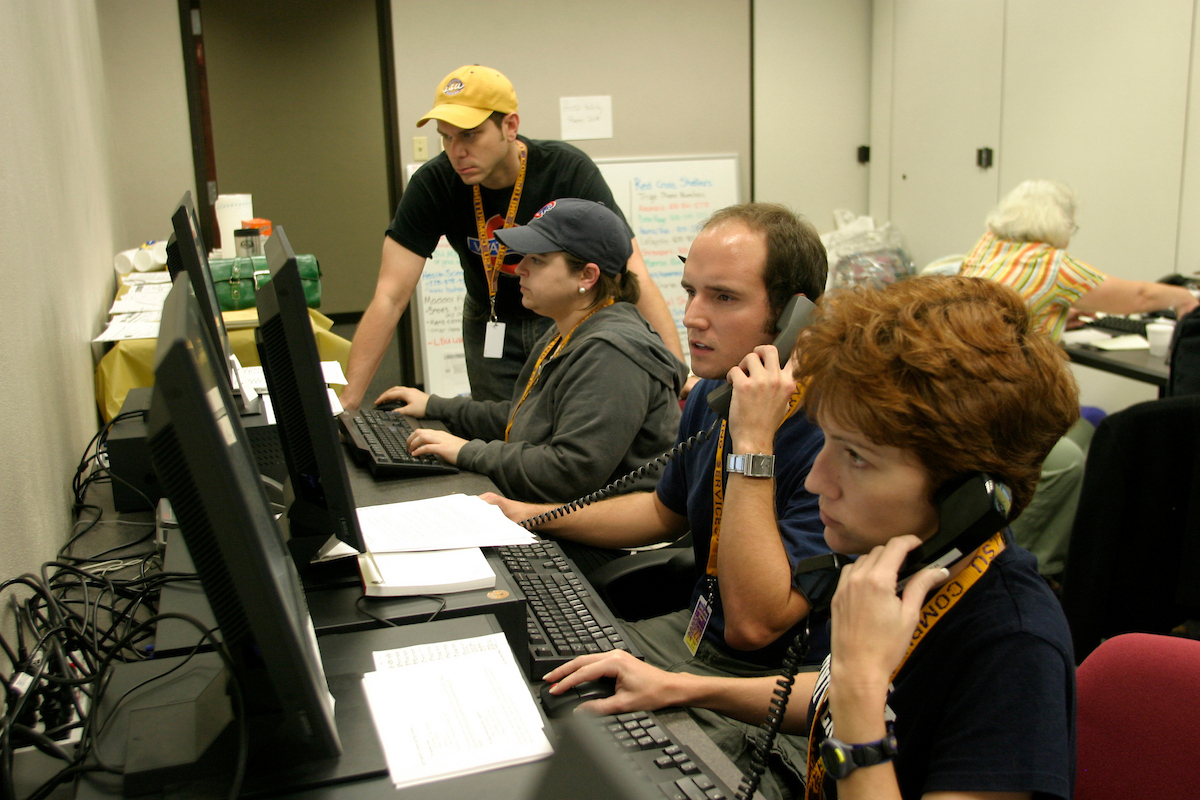
LSU personnel staff a call center on campus following Katrina.
Value to the State
Nearly 20 years after Katrina, LSU’s legacy in disaster response and resilience remains one of its most vital contributions to Louisiana. The investment in applied research, community collaboration, and public service has helped the state not only recover but rebuild smarter.
Today, Louisiana is better equipped to face extreme weather, thanks in large part to LSU’s commitment to solving real-world problems and serving the public good.
Katrina left deep scars on Louisiana, but also revealed the strength of its people and institutions. LSU rose to meet the moment, then and now, by turning tragedy into a catalyst for innovation and lasting change for our neighbors in Louisiana and around the world.
Explore LSU’s role in response, recovery, resilience, and research following Hurricane
Katrina.Turning Tragedy into Impact
